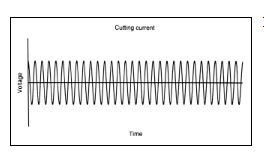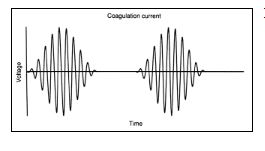Electrosurgical Units and their Physics
Introduction:
In the current scenario it is difficult to dream of performing a surgery in the absence of a good cautery machine. It is fairly safe to use and helps the surgeon by sealing the bleeders effectively. It reduces the operating time also because of its excellent hemostatic effect. It was Bovie who played a pioneer role in designing the first surgical diathermy machine in 1928. This invention served as a turning point in the field of surgery. This equipment is being used for cutting and coagulating even today. It has become the most indispensable armament in a surgeon's armory.
The principle:
A diathermy machine converts electricity of the main supply (240v, 50 Hz) into high frequency current (>100,000 Hz) in order to minimize the risk of electrical shock to the patient. It works in two modes commonly i.e Monopolar and Bipolar modes.
Monopolar mode:
In this mode the current from the diathermy machine enters the patient through the active electrode and exits through the gounding pad which is usually kept under the thigh of the patient during surgery. Heat is generated at the point of contact causing thermal coagulation and ablation of tissue.
Bipolar mode:
In this mode the current passes between the two prongs of the electrode without any significant flow through the patient and hence there is no need for placement of the grounding electrode pad. The two tips of the forceps perform the active and return electrode functions. Only when the tissue is grasped between the tips of the forcept the circuit closes causing the current to flow causing coagulation and thermal ablation. Bipolar cautery works regardless of the medium in which it is used, and can even be used to cauterize tissue in even a wet field. Hence it is also known as "wet field" cautery.
Safety tips:
Electrosurgical units produce very high current that could cause injury to both the surgeon and the patient if not used properly. Major complications due to their use like burns at the return electrode sites and surgical fires are some of the documented disaster scenarios.
Do's:
1. The diathermy hand piece should always be placed in a holster that is non conductive when not in use.
2. It should always be used at the lowest setting (generator setting) that could achieve the desired surgical effect. When higher than necessary voltages are used then there is always the risk of arcing. If higher voltage settings are needed then the skin pad should be changed because it would have been compromised.
3. The electrode tip should be cleaned frequently during surgery because eschar due to dead tissue caused by burning will cause an increase in electrical impedance leading to arcing. The eschar that builds at the tip of the electrode should be wiped with a sponge and not with a scratch pad because these pads will scratch grooves into the electrode tip causing increase in the eschar build up.
Dont's
1. Electrosurgical units should not be used in the presence of flammable agents / oxygen rich environments.
2. Using flammable substances that can be ignited by sparks such as alcohol should be avoided inside the operation theatre. If alcohol needs to be used as disinfectant then care should be taken not to allow it to pool anywhere near the patient. Before using cautery it should be ensured that the operating field should be dry of all flammable substances.
3. Rubber catheters should not be used as a sheath to cover active electrode tips.
4. Cables should never be wrapped around metal instruments because current could pass through metal instruments causing burns.
5. These instruments should not be operated with wet hands or while standing over wet surface. The foot pedal should also be kept dry.
Monopolar cautery:
1. Before using monopolar cautery it should be ensured that the patient is not having any metal implants including cardiac pacemakers. There is always a risk of injury when return electrode is placed on the skin over a metal ortho implant.
2. Patient should not be wearing any jewellery
3. The return electrode should be placed as close to the operative site as possible and that area should be dry and well vascularized. Ideally it is placed over a large muscle mass. Bony prominences, adipose tissue, scar tissue and skin over implants should be avoided.
4. The ECG electrodes should be placed away from the electrosurgery site and the current pathway through the body.
Physics of Electrosurgical Unit:
Despite the fact that surgeons have been using this equipment for more than a century their knowledge about the physics involved is rather poor. Basic knowlege of electrophysics will help the surgeon in utilizing this equipment more carefully and effectively. Basic unit of electro cautery is the generator which generates the current. Power of current generated is measured in watts.
Watts = Ampere x volts.
Generators in electrosurgical units are capable of producing a variety of current wave forms. These different wave forms can be used in surgery to create differing effects on the tissue.
Basically electric current is off two types:
Direct current:
This is a constant current and never changes its direction (i.e polarity) or magnitude. This type of current is produced by batteries. This type of current is not used in surgery because it can produce depolarization of neural and muscular tissue.
Alternate current:
This type of current is named thus because its polarity (direction) changes alternatingly. The rapidity with which the direction of current flow changes per unit time is known as the frequency and is measured in Hertz (Hz). One complete cycle per second is equal to one Hz. If the current alters its polarity a million times per second then it is one megahertz current. Electrosurgical genertors typically operate at frequencies between 400,000 Hz and 2.5 MHz. Some high end generators can produce currents with frequencies as high as 3.5 MHz. Since these frequency falls within the radio frequency they are also known as radio frequency generators and are also known to produce radio waves as a byproduct. Excessively high / low frequencies can produce undesirable side effects during surgery. Depolarization of susceptible tissues ceases at frequencies above 10,000 Hz. Excessively high frequencies tend to cause leakage of current.
Cutting current:
This is used to cut tissues during surgery. This current is pure and is available in nonmodulated sinusoidal waveform. This waveform achieves higher average power when compared to other alternating wave form of equal peak voltage. This allows voltage to be limited. This high power creates a higher current density facilitating cutting action without extensive thermal damage.
Coagulation current:
This current is characterized by extensive wave modulation, producing intermittent burts of damped sine waves of high peak voltages. These high peak voltages result in high tissue temperatures causing significant thermal destruction of tissue making this current suited for coagulation of bleeding vessels.
Blended current:
This type of current allows the surgeon to cleanly divide tissue while maintaining reasonable degree of hemostasis depending on the coagulation current used. Blended currents are created by modulating a second, lower frequency higher amplitude sine wave with the sine wave from the cutting generator producing a higher peak to peak voltage. This wave form is delivered in intermittent bursts at a rate determined by the settings of the electrosurgical generator. This burst effect delivered at higher peak to peak voltage contains a lower average power than a pure sinusoidal waveform because of the duty cycle.
Rectified current:
This is used in dermatological surgery. In this type the alternating current is modified so that it becomes unidirectional. This is usually done by blocking the portion of the wave with negative polarity or by reversing the negative portion of the wave (this is known as full rectification). This type of current is time varying because its flow is not constant even though its polarity does not change.


